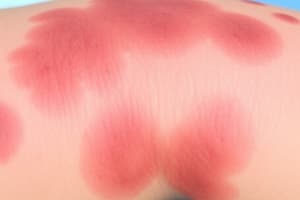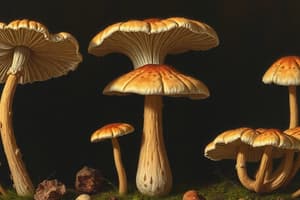Podcast
Questions and Answers
Match the type of algae with their notable characteristics:
Match the type of algae with their notable characteristics:
Brown algae = Multicellular and macroscopic, produce algin Red algae = Harvested for agar and carrageenan Green algae = Gave rise to terrestrial plants, store starch Diatoms = Unicellular algae with silica cell walls
Match the fungal application with their respective organisms:
Match the fungal application with their respective organisms:
Saccharomyces cerevisiae = Bread, wine, hepatitis B vaccine Paecilomyces = Kills termites Trichoderma = Produces cellulase Usnea = Antimicrobial properties
Match the groups with their characteristics in the domain Archaea:
Match the groups with their characteristics in the domain Archaea:
Halophiles = Require salt concentration greater than 25% Thermophiles = Require growth temperature over 80°C Gram Positive Bacteria = Thick peptidoglycan cell wall, stain purple Gram Negative Bacteria = Thin peptidoglycan wall, stain pink
Match the definitions to the appropriate terms in microbiology:
Match the definitions to the appropriate terms in microbiology:
Match the components of the fungal lifecycle with their functions:
Match the components of the fungal lifecycle with their functions:
Match the terms related to viral lifecycle to their definitions:
Match the terms related to viral lifecycle to their definitions:
Match the catchall kingdoms with their descriptions:
Match the catchall kingdoms with their descriptions:
Match the economic importance of lichens with their uses:
Match the economic importance of lichens with their uses:
Match the following fungal types with their definitions:
Match the following fungal types with their definitions:
Match the following classifications of bacteria with their characteristics:
Match the following classifications of bacteria with their characteristics:
Match the following phyla with their respective characteristics:
Match the following phyla with their respective characteristics:
Match the following historical events with their related fungi:
Match the following historical events with their related fungi:
Match the following bacterial groups with their subgroups:
Match the following bacterial groups with their subgroups:
Flashcards are hidden until you start studying
Study Notes
Mycosis
- Fungal infections
- Opportunistic mycoses are caused by fungi that are harmless in their natural habitat but become pathogenic in a compromised host.
- Zombie ant fungus (Cordyceps and Ophiocordyceps unilateralis) is an insect pathogen that exhibits mind control.
- Chondrostereum purpureum is a plant fungus that infected a human in 2023.
- Morphological characteristics are useful for identifying eukaryotes, but tell little about phylogenetic relationships.
Archaea classification
- Archaea are a distinct taxonomic grouping.
- They lack peptidoglycan.
Spirochaetes
- Cause syphilis and Lyme disease.
Proteobacteria
- Gram-Negative
Alphaproteobacteria
- A class under the Proteobacteria phylum.
- Includes Ehrlichia, Agrobacterium, and Rickettsia.
Gammaproteobacteria
- A class under the Proteobacteria phylum.
- Includes Vibrio, Salmonella, Helicobacter, and Escherichia.
Bacilli (Endospores)
- Belongs to the Firmicutes phylum.
Bacilli (Clostridia)
- Gram-Positive
- Belongs to the Firmicutes phylum.
Lactobacillales
- Gram-Positive
- Belongs to the Firmicutes phylum.
Subgroups of Lactobacillales
- Gram-Positive
- Staphylococcus
- Streptococcus
Actinobacteria
- Gram-Positive
Bacteroidetes
- Gram-Negative
- Many opportunistic pathogens.
Heterotrophic organisms
- Gain nutrients through absorption.
Saprophytic
- Feed on dead matter.
Filamentous fungi
- Include molds and fleshy fungi.
Organ Transplants
- Tolypocladium inflatum produces cyclosporine, which helps suppress the immune system and is used in organ transplant patients.
Salem Witch Trials
- Mostly started due to erratic behavior after consuming rye products with ergot fungus growing on them in 1692.
Ascomycota
- Ascospores are produced sexually.
- Nuclei morphologically similar or dissimilar fuse in a saclike ascus.
Lichens
- Economic importance:
- Dyes
- Antimicrobial (Usnea)
- Litmus
- Food for herbivores
Paecilomyces
- Kills termites.
Trichoderma
- Produces cellulase.
Saccharomyces cerevisiae
- Used in bread, wine, and hepatitis B vaccine production.
Brown Algae
- Cellulose and alginic acid cell walls.
- Multicellular and macroscopic.
- Produce algin, a thickener used in foods.
Red Algae
- Have branched thalli.
- Most are multicellular.
- Harvested for agar and carrageenan.
- Some produce a lethal toxin.
Green Algae
- Cellulose cell walls.
- Unicellular or multicellular.
- Chlorophyll a and b.
- Store starch.
- Gave rise to terrestrial plants.
Diatoms
- Produce domoic acid, which can cause neurological disease.
- Can be contracted by swimming in saltwater affected by algal blooms.
Protista
- Catchall kingdom for diverse eukaryotic organisms.
- Clades are groups based on rRNA genetic similarities.
- Protists are eukaryotes excluding fungi, animals, and plants.
- Algae are photosynthesizing protists, not a formal taxonomic group.
- Green algae gave rise to terrestrial plants and store starch.
- Diatoms are unicellular algae with silica cell walls and store oil.
- Oomycota are water molds, decomposers related to brown algae.
- Trophozoite is the feeding and growing form of protozoa.
- Uncoating is the process where viral or host enzymes release viral components.
- Crustacea have four antennae.
Archaea
- A domain of prokaryotes, often extremophiles.
Morphological Characteristics
- Physical traits used for identifying eukaryotes.
Differential Staining
- Techniques like Gram staining used to classify bacteria.
Biochemical Tests
- Tests that determine the presence of bacterial enzymes.
Culture
- Bacteria grown in laboratory media.
Clone
- Population derived from a single parent cell.
Variant
- A slight genetic difference without functional change.
Strain
- Accumulated genetic differences affecting behavior.
Viral Species
- Population of viruses occupying a specific niche.
Halophiles
- Require salt concentration greater than 25%.
Thermophiles
- Require growth temperature over 80°C.
Gram Positive Bacteria
- Have a thick peptidoglycan cell wall and stain purple.
Gram Negative Bacteria
- Have a thin peptidoglycan wall and stain pink.
Endospores
- Resistant structures formed by certain bacteria.
Endosymbiotic Theory
- A proto-eukaryote engulfed a protomitochondrion.
Protista
- A catchall kingdom for a variety of organisms; autotrophic and heterotrophic.
Fungi
- Chemoheterotrophic; unicellular or multicellular; cell walls of chitin; develop from spores or hyphal fragments.
Plantae
- Multicellular; cellulose cell walls; undergo photosynthesis.
Animalia
- Multicellular; no cell walls; chemoheterotrophic.
Mycology
- The study of fungi.
Hyphae
- Filaments that make up the fungal thallus (body).
Mycelium
- A mass of hyphae.
Septate hyphae
- Hyphae that contain cross-walls.
Coenocytic hyphae
- Hyphae that do not contain septa.
Fungal lifecycle
- Fungi reproduce sexually and asexually via the formation of spores.
Studying That Suits You
Use AI to generate personalized quizzes and flashcards to suit your learning preferences.




